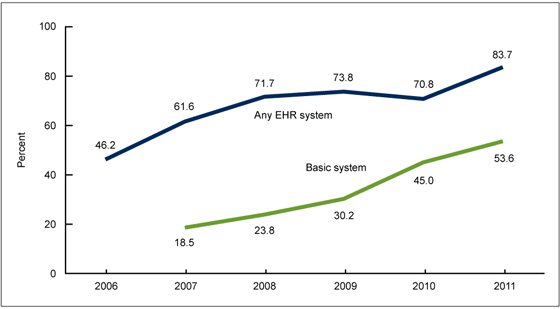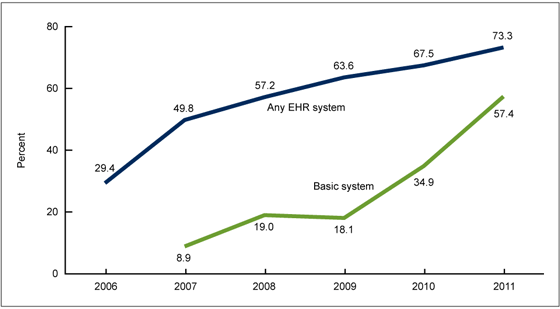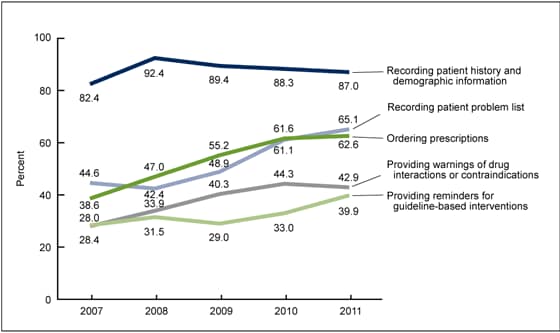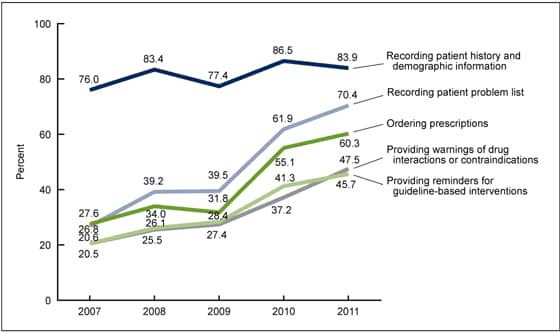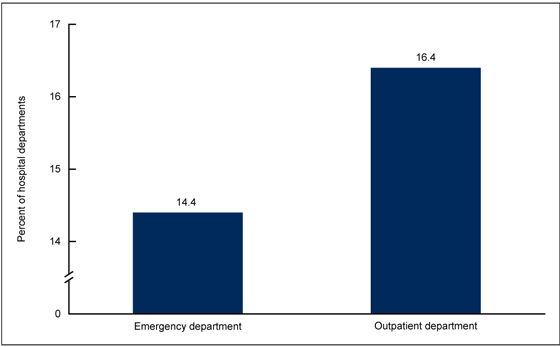Progress With Electronic Health Record Adoption Among Emergency and Outpatient Departments: United States, 2006–2011
- Key findings
- Use of an EHR system in EDs increased from 2006 through 2011.
- Use of an EHR system in OPDs increased from 2006 through 2011.
- From 2007 through 2011, the percentage of EDs with EHR technology that supported Stage 1 Meaningful Use objectives increased.
- From 2007 through 2011, hospital OPDs with EHR technology that supported Stage 1 Meaningful Use objectives increased.
- Summary
- Definitions
- Data source and methods
- About the authors
- References
- Suggested citation
NCHS Data Brief No. 187, February 2015
PDF Versionpdf icon (660 KB)
Eric Jamoom, Ph.D., M.P.H., M.S.; and Esther Hing, M.P.H.
Key findings
Data from the 2006–2011 National Hospital Ambulatory Medical Care Survey
- In 2011, 84% of hospital emergency departments (EDs) used an electronic health record (EHR) system.
- Adoption of a basic EHR system with a specific set of functionalities by EDs increased from 19% in 2007 to 54% in 2011.
- In 2011, 73% of hospital outpatient departments (OPDs) used an EHR system, up from 29% in 2006.
- Adoption of a basic EHR system with a specific set of functionalities by OPDs increased from 9% in 2007 to 57% in 2011.
- From 2007 through 2011, adoption of Stage 1 Meaningful Use objectives by EDs and OPDs increased.
- In 2011, 14% of EDs and 16% of OPDs had EHR technology able to support nine Stage 1 Meaningful Use objectives.
The Health Information Technology for Economic and Clinical Health (HITECH) Act of 2009 provides incentive payments to eligible hospitals and providers that demonstrate the meaningful use of a certified electronic health record (EHR) system (1,2). This report describes the adoption of EHRs in hospital emergency departments (EDs) and outpatient departments (OPDs) from 2006 through 2011 using the National Hospital Ambulatory Medical Care Survey (NHAMCS).
Keywords: health information technology • National Hospital Ambulatory Medical Care Survey
Use of an EHR system in EDs increased from 2006 through 2011.
- In 2011, 84% of EDs reported using an EHR system, up from 46% in 2006 (Figure 1).
Figure 1. Hospital emergency departments with an EHR system: United States, 2006–2011
NOTES: All trends were significant (p < 0.05). EHR is electronic health record. “Any EHR system” is a medical or health record system that is either all or partially electronic. Emergency department estimates are based on a question indicating the department “uses” an EHR. Estimates for a basic system prior to 2007 were not included, as not all data elements were collected. A basic system had all of the following functionalities: patient history and demographics, patient problem lists, physician clinical notes, comprehensive list of patients’ medications and allergies, computerized orders for prescriptions, and ability to view laboratory and imaging results electronically.
SOURCE: CDC/NCHS, National Hospital Ambulatory Medical Care Survey, 2006–2011.
- Adoption of a basic EHR system by hospital EDs increased from 19% in 2007 to 54% in 2011.
Use of an EHR system in OPDs increased from 2006 through 2011.
- OPD use of an EHR system increased from 29% in 2006 to 73% in 2011 (Figure 2).
- OPD adoption of a basic EHR system increased from 9% in 2007 to 57% in 2011.
Figure 2. Hospital outpatient departments with an EHR system: United States, 2006–2011
NOTES: All trends were significant (p < 0.05). EHR is electronic health record. “Any EHR system” is a medical or health record system that is either all or partially electronic. Outpatient department estimates are based on a question indicating the department “uses” an EHR. Estimates for a basic system prior to 2007 are not included, as not all data elements were collected. A basic system had all of the following functionalities: patient history and demographics, patient problem lists, physician clinical notes, comprehensive list of patients’ medications and allergies, computerized orders for prescriptions, and ability to view laboratory and imaging results electronically.
SOURCE: CDC/NCHS, National Hospital Ambulatory Medical Care Survey, 2006–2011.
From 2007 through 2011, the percentage of EDs with EHR technology that supported Stage 1 Meaningful Use objectives increased.
- Information on 5 of 14 Stage 1 Meaningful Use objectives was collected in NHAMCS from 2007 through 2011.
- Over the 5-year period, EDs with an EHR system able to support Stage 1 objectives increased for the following four objectives: providing warnings of drug interactions or contraindications (from 28% to 43%), providing reminders for guideline-based interventions (from 28% to 40%), ordering prescriptions (from 39% to 63%), and recording patient problem list (from 45% to 65%) (Figure 3).
- In 2011, EDs with an EHR system able to support Stage 1 Meaningful Use objectives ranged from 40% (providing reminders for guideline-based interventions) to 87% (recording patient demographics).
Figure 3. Hospital emergency departments with EHR technology able to support selected Stage 1 Meaningful Use objectives: United States, 2007–2011
NOTES: All trends were significant (p < 0.05) except for recording patient demographics. EHR is electronic health record. Information on 5 of 14 Stage 1 Meaningful Use objectives was collected in the National Hospital Ambulatory Medical Care Survey from 2007 through 2011. See reference 4 for Stage 1 Meaningful Use objectives.
SOURCE: CDC/NCHS, National Hospital Ambulatory Medical Care Survey, 2007–2011.
From 2007 through 2011, hospital OPDs with EHR technology that supported Stage 1 Meaningful Use objectives increased.
- Information on 5 of 14 Stage 1 Meaningful Use objectives was collected in NHAMCS from 2007 through 2011.
- Over the 5-year period, OPDs with an EHR system able to support Stage 1 objectives increased for the following four objectives: recording patient problem lists (from 28% to 70%), ordering prescriptions (from 27% to 60%), providing warnings or contraindications (from 21% to 48%), and providing guideline-based interventions (from 21% to 46%) (Figure 4).
- In 2011, OPDs with an EHR system able to support Stage 1 Meaningful Use objectives ranged from 46% (providing reminders for guideline-based interventions) to 84% (recording patient demographics).
Figure 4. Hospital outpatient departments with EHR technology able to support selected Stage 1 Meaningful Use objectives: United States, 2007–2011
NOTES: All trends were significant (p < 0.05) except for recording patient demographics. EHR is electronic health record. Information on 5 of 14 Stage 1 Meaningful Use objectives was collected in the National Hospital Ambulatory Medical Care Survey from 2007 through 2011. See reference 4 for Stage 1 Meaningful Use objectives.
SOURCE: CDC/NCHS, National Hospital Ambulatory Medical Care Survey, 2007–2011.
In 2011, a limited number of EDs and OPDs had an EHR system that supported nine Stage 1 Meaningful Use objectives.
- In 2011, information on 9 of 14 Stage 1 Meaningful Use objectives was collected in NHAMCS.
- In 2011, 14% of EDs had EHR technology able to support 9 of 14 Stage 1 Meaningful Use objectives, while 16% of OPDs had such EHR technology (Figure 5).
Figure 5. Hospital outpatient and emergency departments with EHR technology able to support nine Stage 1 Meaningful Use objectives: United States, 2011
NOTES: Data include nonfederal hospitals. In 2011, information on nine Stage 1 Meaningful Use objectives was collected in the National Hospital Ambulatory Medical Care Survey. See reference 4 for Stage 1 Meaningful Use objectives. EHR is electronic health record.
SOURCE: CDC/NCHS, National Hospital Ambulatory Medical Care Survey, 2011.
Summary
Adoption of EHRs by hospital EDs and OPDs has increased. From 2006 through 2011, use of EHR systems increased significantly. In 2011, 84% of EDs and 73% of OPDs used an EHR system.
From 2007 through 2011, the percentage of hospitals reporting having an EHR system that met the criteria for a basic system increased among EDs (from 19% to 54%) and OPDs (from 9% to 57%).
The HITECH Act of 2009 gave hospitals monetary incentives to adopt EHR systems. To receive incentive payments through the Centers for Medicare & Medicaid Services, hospitals had to meet federal standards of “meaningful use” of EHRs in three stages. Payments for Stage 1 of the EHR Incentive Programs began in fiscal year 2011, and payments for Stage 2 began in fiscal year 2014. From 2007 through 2011, five EHR Stage 1 core set objectives for demonstrating meaningful use were consistently collected in NHAMCS. Four of these five objectives increased significantly in both EDs and OPDs from 2007 through 2011. In 2011, information on 9 of the 14 Stage 1 Meaningful Use objectives was collected in NHAMCS. Using 2011 data, the year with the most complete data on hospital readiness to meet Stage 1 core set objectives for demonstrating meaningful use, this report found that 14% of EDs and 16% of OPDs had EHR technology able to support nine Stage 1 core set objectives.
This study is limited in that its estimate of hospital readiness for Stage 1 Meaningful Use objectives overestimates hospital readiness because NHAMCS only measures 9 of 14 objectives, and hospital departments are limited to EDs and OPDs. To receive Meaningful Use incentive payments, hospitals have to meet 14 core set objectives and 5 of 10 menu set objectives.
Definitions
Basic system: A system that had all of the following functionalities: patient history and demographics, patient problem lists, physician clinical notes, comprehensive list of patients’ medications and allergies, computerized orders for prescriptions, and ability to view laboratory and imaging results electronically (3).
Demonstrating meaningful use: The Medicare and Medicaid EHR Incentive Programs provide incentive payments to hospitals as they demonstrate meaningful use of certified EHR technology. The Centers for Medicare & Medicaid Services established the objectives for meaningful use in three stages that hospitals must meet in order to receive an incentive payment (4). From 2011 through 2012, hospitals could receive incentive payments if they demonstrated 14 of the Stage 1 core objectives for meaningful use, and 5 of 10 menu set objectives. The full list of Stage 1 objectives and measures is published (1,2). The Table presents Stage 1 Meaningful Use core set objectives and corresponding 2011 NHAMCS EHR survey items.
Table. Meaningful Use Stage 1 core set objectives and corresponding NHAMCS EHR survey items
| Meaningful Use objective | 2011 NHAMCS |
|---|---|
| Computerized provider order entry for medications | Prescription order entry |
| Drug-drug and drug-allergy interaction checks | Drug interactions or contraindication warnings |
| Record patient demographics | Patient history and demographic information |
| Maintain up-to-date problem list of current and active diagnoses |
Patient problem list |
| Maintain active medication list | Clinical notes include a list of current medications and allergies |
| Maintain active medication allergy list | Combined with above category |
| Vital signs | … |
| Smoking status | … |
| Implement one clinical decision support rule and ability to track compliance with rule |
Reminders for guideline-based interventions or screening tests and warnings of drug interactions orcontraindications provided |
| Calculate and transmit Centers for Medicare & Medicaid Services quality measure |
… |
| Electronic copy of health information | … |
| Clinical summaries | Providing patients with clinical summaries for each visit |
| Exchange key clinical information | Exchanges clinical summaries electronically with other providers |
| Privacy and security | … |
… Category not applicable; no corresponding survey item.
NOTES: NHAMCS is National Hospital Ambulatory Medical Care Survey; EHR is electronic health record.
Data source and methods
The data for this report are from the 2006–2011 NHAMCS, an annual, nationally representative survey of EDs and OPDs in nonfederal, general, and short-stay hospitals. It is designed to produce national estimates of EDs and OPDs. NHAMCS is conducted by the Centers for Disease Control and Prevention’s National Center for Health Statistics. More details about NHAMCS methodology are available (5).
Data analyses were performed using the statistical packages SAS version 9.3 (SAS Institute, Cary, N.C.) and SUDAAN version 10.0 (RTI International, Research Triangle Park, N.C.). Numbers presented in the text were rounded to the nearest integer for ease of interpretability.
About the authors
Eric Jamoom and Esther Hing are with CDC’s National Center for Health Statistics, Division of Health Care Statistics, Ambulatory and Hospital Care Statistics Branch.
References
- Blumenthal D, Tavenner M. The “meaningful use” regulation for electronic health records. N Engl J Med 363(6):501–4. 2010.
- Hing E, Hall MJ, Ashman JJ. Use of electronic medical records by ambulatory care providers: United States, 2006pdf icon. National health statistics reports; no 22. Hyattsville, MD: National Center for Health Statistics. 2010.
- Hsiao CJ, Hing E, Socey TC, Cai B. Electronic health record systems and intent to apply for meaningful use incentives among office-based physician practices: United States, 2001–2011. NCHS data brief, no 79. Hyattsville, MD: National Center for Health Statistics. 2011.
- Centers for Medicare & Medicaid Services. EHR incentive programs: The official web site for the Medicare and Medicaid electronic health records (EHR) incentive programsexternal icon.
- NCHS. National Hospital Ambulatory Medical Care Survey. Public-use data file documentation, 2001-2010.
Suggested citation
Jamoom E, Hing E. Progress with electronic health record adoption among emergency and outpatient departments: United States, 2006–2011. NCHS data brief, no 187. Hyattsville, MD: National Center for Health Statistics. 2015.
Copyright information
All material appearing in this report is in the public domain and may be reproduced or copied without permission; citation as to source, however, is appreciated.
National Center for Health Statistics
Charles J. Rothwell, M.S., M.B.A., Director
Nathaniel Schencker, Ph.D., Deputy Director
Jennifer H. Madans, Ph.D., Associate Director for Science
Division of Health Care Statistics
Clarice Brown, M.S., Director
